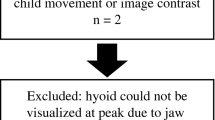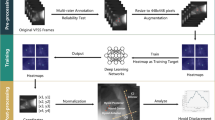Abstract
Conventional kinematic analysis of videofluoroscopic (VF) swallowing image, most popular for dysphagia diagnosis, requires time-consuming and repetitive manual extraction of diagnostic information from multiple images representing one swallowing period, which results in a heavy work load for clinicians and excessive hospital visits for patients to receive counseling and prescriptions. In this study, a software platform was developed that can assist in the VF diagnosis of dysphagia by automatically extracting a two-dimensional moving trajectory of the hyoid bone as well as 11 temporal and kinematic parameters. Fifty VF swallowing videos containing both non-mandible-overlapped and mandible-overlapped cases from eight patients with dysphagia of various etiologies and 19 videos from ten healthy controls were utilized for performance verification. Percent errors of hyoid bone tracking were 1.7 ± 2.1% for non-overlapped images and 4.2 ± 4.8% for overlapped images. Correlation coefficients between manually extracted and automatically extracted moving trajectories of the hyoid bone were 0.986 ± 0.017 (X-axis) and 0.992 ± 0.006 (Y-axis) for non-overlapped images, and 0.988 ± 0.009 (X-axis) and 0.991 ± 0.006 (Y-axis) for overlapped images. Based on the experimental results, we believe that the proposed platform has the potential to improve the satisfaction of both clinicians and patients with dysphagia.







Similar content being viewed by others
References
Ertekin C, Aydogdu I, Yuceyar N, Kiylioglu N, Tarlaci S, Uludag B. Pathophysiological mechanisms of oropharyngeal dysphagia in amyotrophic lateral sclerosis. Brain. 2000;123:125–40.
Han TR, Paik NJ, Park JW. Quantifying swallowing function after stroke: a functional dysphagia scale based on videofluoroscopic studies. Arch Phys Med Rehab. 2001;82:677–82.
Ryu JS, Kang JY, Park JY, et al. The effect of electrical stimulation therapy on dysphagia following treatment for head and neck cancer. Oral Oncol. 2009;45:665–8.
Golabbakhsh M, Rajaei A, Derakhshan M, Sadri S, Taheri M, Adibi P. Automated acoustic analysis in detection of spontaneous swallows in Parkinson’s disease. Dysphagia. 2014;29:572–7.
DeFabrizio ME, Rajappa A. Contemporary approaches to dysphagia management. J Nurse Pract. 2010;6:622–30.
Yamamura K, Kitagawa J, Kurose M, et al. Neural mechanisms of swallowing and effects of taste and other stimuli on swallow initiation. Biol Pharm Bull. 2010;33:1786–90.
US Census 2010—US Census Bureau. Populations Projections Program. Department of Commerce, Population Division. Accessed https://www.census.gov/aian/census_2010/.
DJO Global. Who is Affected: dysphagia by the numbers. DJO Global. Accessed http://www.djoglobal.com/vitalstim/what-dysphagia/who-affected.
Martino R, Foley N, Bhogal S, Diamant N, Speechley M, Teasell R. Dysphagia after stroke incidence, diagnosis, and pulmonary complications. Stroke. 2005;36:2756–63.
Lazareck LJ, Moussavi ZM. Classification of normal and dysphagic swallows by acoustical means. IEEE Trans Biomed Eng. 2004;51:2103–12.
Smith NR, Klongtruagrok T, DeSouza GN, Shyu CR, Dietrich M, Page MP. Non-invasive ambulatory monitoring of complex sEMG patterns and its potential application in the detection of vocal dysfunctions. E-Health networking, applications and services (Healthcom), 2014 IEEE 16th international conference on. 2014: pp 447–452.
Imtiaz U, Yamamura K, Kong W, Sessa S, Lin Z, Bartolomeo L, Takanishi A. Application of wireless inertial measurement units and EMG sensors for studying deglutition—preliminary results. International Conference IEEE EMBC. 2014: pp 5381–5384.
Kalantarian H, Alshurafa N, Le T, Sarrafzadeh M. Monitoring eating habits using a piezo electric sensor-based necklace. Comput Biol Med. 2015;58:46–55.
Paik NJ, Kim SJ, Lee HJ, Jeon JY, Lim JY, Han TR. Movement of the hyoid bone and the epiglottis during swallowing in patients with dysphagia from different etiologies. J Electromyogr Kines. 2008;18:329–35.
Lee SI, Yoo JY, Kim M, Ryu JS. Changes of timing variables in swallowing of boluses with different viscosities in patients with dysphagia. Arch Phys Med Rehab. 2013;94:120–6.
Wang TG, Chang YC, Chen WS, Lin PH, Hsiao TY. Reduction in hyoid bone forward movement in irradiated nasopharyngeal carcinoma patients with dysphagia. Arch Phys Med Rehabil. 2010;91:926–31.
Stoeckli SJ, Huisman TA, Seifert BA, Martin Harris BJ. Interrater reliability of videofluoroscopic swallow evaluation. Dysphagia. 2003;18:53–7.
Kim DH, Choi KH, Kim HM, et al. Inter-rater reliability of videofluoroscopic dysphagia scale. Ann Phys Rehabil Med. 2012;36:791–6.
Kellen PM, Becker DL, Reinhardt JM, Van Daele DJ. Computer-assisted assessment of hyoid bone motion from videofluoroscopic swallow studies. Dysphagia. 2010;25:298–306.
Canny J. A Computational Approach To Edge Detection. IEEE Trans Pattern Anal Mach Intell. 1986;8:679–98.
Ojala T, Pietikäinen M, Harwood D. A comparative study of texture measures with classification based on featured distributions. Pattern Recogn. 1996;29:51–9.
Ojala T, Pietikäinen M, Mäenpää TT. Multiresolution gray-scale and rotation invariant texture classification with local binary pattern. IEEE Trans Pattern Anal Mach Intell. 2002;24:971–87.
Mccullouh GH, Wertz RT, Rosenbek JC. Sensitivity and specificity of clinical/bedside examination signs for detecting aspiration in adults subsequent to stroke. J Commun Disord. 2001;34:55–72.
Daniels SK, Ballo LA, Mahoney MC, Foundas AL. Clinical predictors of dysphagia and aspiration risk: outcome measures in acute stroke patients. Arch Phys Med Rehabil. 2000;81:1030–3.
Jensen K, Lambertsen K, Grau C. Late swallowing dysfunction and dysphagia after radiotherapy for pharynx cancer: frequency, intensity and correlation with dose and volume parameters. Radiother Oncol. 2007;85:74–82.
O’Neil KH, Purdy M, Falk J, Gallo L. The dysphagia outcome and severity scale. Dysphagia. 1999;14:139–45.
Aboofazeli M, Moussavi Z. Analysis and classification of swallowing sounds using reconstructed phase space features. International Conference IEEE ICASSP’05. 2005: pp 421–424.
Spadotto AA, Gatto AR, Guido RC, Montagnoli AN, Cola PC, Pereira JC, Schelp AO. Classification of normal swallowing and oropharyngeal dysphagia using wavelet. Appl Math Comput. 2009;207:75–82.
Aung SH, Goulermas JY, Hamdy S. Spatiotemporal visualizations for the measurement of oropharyngeal transit time from videofluoroscopy. IEEE Trans Biomed Eng. 2010;57:432–41.
Hsu CC, Chen WH, Chiu HC. Using swallow sound and surface electromyography to determine the severity of dysphagia in patients with myasthenia gravis. Biomed Signal Process Control. 2013;8:432–41.
Reddy NP, Thomas R, Canilang EP, Casterline J. Toward classification of dysphagic patients using biomechanical measurements. J Rehab Res Develop. 1994;31:335–44.
Suryanarayanana S, Reddy NP, Canilang EP. A fuzzy logic diagnosis system for classification of pharyngeal dysphagia. Int J Biomed Comput. 1995;38:207–15.
Chaves RDD, Mangilli LD, Sassi FC, Jayanthi SK, Zilberstein B, Andrade CRFD. Two-dimensional perceptual videofluoroscopic swallowing analysis of the pharyngeal phase in patients older than 50 years. Arq Bras Cir Dig. 2013;26:274–9.
Pearson WG Jr, Molfenter SM, Smith ZM, Steele CM. Image-based measurement of post-swallow residue: the normalized residue ratio scale. Dysphagia. 2013;28:167–77.
Kim Y, McCullough GH. Maximal hyoid excursion in poststroke patients. Dysphagia. 2010;25:20–5.
Molfenter SM, Steele CM. Kinematic and temporal factors associated with penetration-aspiration in swallowing liquids. Dysphagia. 2014;29:269–76.
Bingjie L, Tong Z, Xinting S, Jianmin X, Guijun J. Quantitative videofluoroscopic analysis of penetration-aspiration in post-stroke patients. Neurol India. 2010;58:42–7.
Inamoto Y, Fujii N, Saitoh E, Baba M, Okada S, Katada K, Palmer JB. Evaluation of swallowing using 320-detector-row multislice CT Part II: kinematic analysis of laryngeal closure during normal swallowing. Dysphagia. 2011;26:209–17.
Okada T, Aoyagi Y, Inamoto Y, Saitoh E, Kagaya H, Shibata S, Ueda K. Dynamic change in hyoid muscle length associated with trajectory of hyoid bone during swallowing: analysis using 320-row area detector computed tomography. J Appl Physiol. 2013;115:1138–45.
Acknowledgements
This research was supported by the Basic Science Research Program through the National Research Foundation of Korea (NRF) funded by the Ministry of Science, ICT and Future Planning (NRF-2013R1A1A1004622 and NRF-2015R1D1A1A01058652).
Author information
Authors and Affiliations
Corresponding author
Ethics declarations
Conflict of interest
There are no conflict of interest to report.
Additional information
Jun Chang Lee and Kyoung Won Nam contributed equally to this paper and should therefore be regarded as equivalent first authors.
In Young Kim and Ju Seok Ryu contributed equally to this paper and should therefore be regarded as equivalent corresponding authors.
Electronic Supplementary Material
Below is the link to the electronic supplementary material.
Supplementary material 1 (AVI 22902 kb)
Rights and permissions
About this article
Cite this article
Lee, J.C., Nam, K.W., Jang, D.P. et al. A Supporting Platform for Semi-Automatic Hyoid Bone Tracking and Parameter Extraction from Videofluoroscopic Images for the Diagnosis of Dysphagia Patients. Dysphagia 32, 315–326 (2017). https://doi.org/10.1007/s00455-016-9759-x
Received:
Accepted:
Published:
Issue Date:
DOI: https://doi.org/10.1007/s00455-016-9759-x




